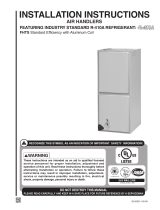
13
speed fan operation. To select this option,
break the tab located on top of the control board
marked “BREAK FOR LOW SPEED CONT
FAN”. When the tab is broken and G is ener-
gized without Y, the air handler will operate
using the heating speed. With the tab broken
and G & Y or Y is energized, the air handler will
operate in the selected cooling speed (includ-
ing 40 sec blower-off delay).
NOTE: To achieve continuous low speed fan
operation Y must be connected at the air
handler.
Selecting Proper Airflow for Variable Speed
Units — Variable speed air handlers are
equipped with a microprocessor-controlled
variable speed motor that is pre-programmed
to deliver optimum airflow in a variety of
conditions and system configurations. Before
operation, the air handler must be configured to
match the unit with the system, system options,
and climatic conditions. Once configured, the
air handler responds directly to the thermostat
inputs, as well as the optional humidistat (Section
7) and bonnet switch (Section 8) (if installed).
During normal operation, the motor will gradually
change speeds during start-up, shut down,
when thermostat inputs change, and when the
duct static pressure changes (vents closed or
opened, filter clogging, etc.). The air handler is
configured by setting the selector switches and
removing jumper connectors as directed below.
IMPORTANT! This air handler has been
designed to give the installer maximum
flexibility to optimize system performance,
efficiency, and comfort. Because there are
so many different ways to set up the air
handler it is important to read and follow
these directions carefully.
Determining Nominal System Capacity
—
In order to select the appropriate airflows for the
air handler the nominal system capacity must
be known. The nominal system capacity is
always the nominal capacity of the outdoor unit.
In some cases the nominal system capacity is
not the same as the nominal capacity of the air
handler. Always refer to the nominal capacity
of the outdoor unit to determine the nominal
system capacity.
Selecting the Basic Cooling/Heat Pump
Airflow
— The basic cooling/heat-pump airflow
is selected by setting switches 1 through 4 on
the thermostat input board located on the
blower. All airflows for other modes of operation
(except electric heat) are determined by this
basic setting.
Table 2 shows the basic airflow values versus
the airflow selector switch settings. Table 2
also shows the range of basic air flow settings
recommended for each nominal system
capacity.
Note: The 15+ SEER variable speed air han-
dlers that are matched with a 2-stage cooling
outdoor unit, are programmed to operate at
75% of the selected airflow while the system is
in the lo-cool mode and 100% of the selected
airflow while in hi-cool mode.
NOTE: The CFM values listed in the tables are
not dependent on duct static pressure. The
motor automatically compensates for changes
in duct static pressure (within the limits of the
motor).
For maximum capacity and energy efficiency,
select an airflow at or near the top of the range
for that nominal capacity. For maximum
dehumidification, select an airflow near the
middle or bottom of the range for that nominal
capacity. Additional information on humidity
control can be found in the sections labeled
“Humidistat” and “Delay Setting”.
NOTE: If coil icing is observed, the basic
cooling/heat-pump airflow selected may be too
low. Double-check to be sure the setting
selected is within the range shown in Table 2.
Also check to be sure the system is properly
charged (see outdoor unit Installation
Instructions). If icing continues to occur, raise
the selected airflow one or two steps.
When operating in the heat pump mode, a
higher basic airflow setting will increase the
energy efficiency and capacity but will also
decrease the supply air temperature. The
optional Bonnet Control Switch may be added
to increase the supply air temperature in the
heat-pump mode when the supply air
temperature is below a comfortable level. For
more details see the section labeled “Bonnet
Control Switch”.
Selecting the Minimum Electric Heat
Airflow
— The minimum electric heat airflow is
selected by setting switches 5 and 6. Selecting
the minimum electric heat airflow sets the
minimum air flow that will be produced whenever


















